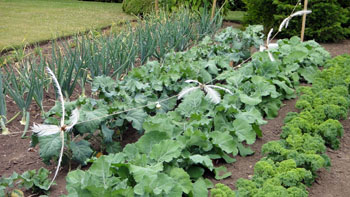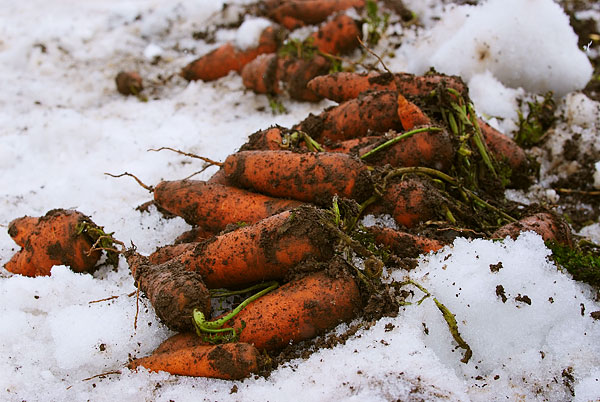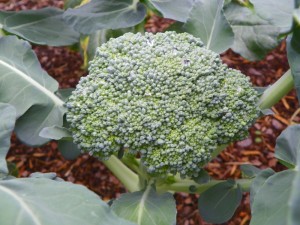Last Chance Vegetable Garden
By Ray Novitske, Fairfax Master Gardener
 We begin to slack off on tending the garden during the heat of August and after months of fighting the bugs and the weeds and diseases. Most flowers are past their prime and we are busy harvesting fruit and vegetables, so we feel all gardened-out this month. But, August is the time to start the second round in our vegetable gardens. If you missed out on starting a vegetable garden this past spring, you now have a second chance.
We begin to slack off on tending the garden during the heat of August and after months of fighting the bugs and the weeds and diseases. Most flowers are past their prime and we are busy harvesting fruit and vegetables, so we feel all gardened-out this month. But, August is the time to start the second round in our vegetable gardens. If you missed out on starting a vegetable garden this past spring, you now have a second chance.
Why fall
Some vegetables are better planted in the fall than spring. Not all crops are appropriate for fall, but those that love the cool weather flourish at this time. In fact, planting quickly-maturing vegetables such as turnips and leafy greens and lettuces can be delayed until September. Root crops such as carrots and radishes can be left in the ground well after the frost and can stay in up to a hard freeze in late fall.
 Fall is a good time for cool season crops because fewer insect pests are buzzing around. Insects are busier in the spring and summer seasons mating, laying eggs, and chomping through our garden. The cooler weather helps slow their activity and end their growing season. Warm days and cool nights produce added sugars in some vegetables, adding flavor and crispness. Fall vegetables also have less competition with annual weeds that are mostly finished for the season as September and October roll around.
Fall is a good time for cool season crops because fewer insect pests are buzzing around. Insects are busier in the spring and summer seasons mating, laying eggs, and chomping through our garden. The cooler weather helps slow their activity and end their growing season. Warm days and cool nights produce added sugars in some vegetables, adding flavor and crispness. Fall vegetables also have less competition with annual weeds that are mostly finished for the season as September and October roll around.
How to start
Decide what to do with the remains of the summer garden, especially since some of it can begin to look a little ragged. You may want to keep some of the plants going through the frost if they are performing well. Note that the sun begins sinking lower in the sky during the fall. Some areas with full sun in the summer may get more shade as the sun gets lower and shadows increase.
You may need to perform some different tasks to prepare for your fall vegetable planting. First, remember that our summers can be hot and dry. Soils may form a hard crust over seed you plant, interfering with the young seedlings and germination, especially in heavy clay soils. Be sure to loosen up the soil so seedlings can break through and young roots can penetrate. Before sowing second season crops, mix some fertilizer or organic material into the soil to replace what earlier plants have used up.
Water the seedlings as they start out. Late summer can be hot, and dry weather can devastate a seedling. Success depends on having adequate moisture available to keep the young seedlings actively growing after germination. You may need to cover the seeded area with burlap cloth, newspapers, or boards to keep the soil cool and moist. Spinach and lettuce seeds will not germinate if the soil temperature exceeds 85 degrees. It is best to wait until September to sow these to be sure the weather cooperates.
Lastly, fall crops grow more slowly than in spring due to the shorter days. When determining planting time and days until harvest found on most seed packets, add one to two weeks if planted in the fall. Days to harvest numbers are estimates based not on when the seeds are planted, but on when the seeds have germinated, and the small plants are growing.
What to plant
 Select crops that prefer cooler weather, and those that have short growing seasons. Vegetables that tolerate light frost can have longer growing seasons. Our first frost normally arrives during the second half of October. Most of the semi-hardy and hardy vegetables will require little or no frost protection. The more tender cool weather vegetables can survive a light frost, but should be harvested before a heavy freeze. A heavy freeze is one that will freeze standing water.
Select crops that prefer cooler weather, and those that have short growing seasons. Vegetables that tolerate light frost can have longer growing seasons. Our first frost normally arrives during the second half of October. Most of the semi-hardy and hardy vegetables will require little or no frost protection. The more tender cool weather vegetables can survive a light frost, but should be harvested before a heavy freeze. A heavy freeze is one that will freeze standing water.
However, the more tender vegetables with a longer growing season can usually be kept past the first frost with a little extra care. We usually enjoy several more weeks of growing conditions after the first frost. Covering plants with sheets, newspaper, burlap, or floating row covers on those first frosty nights can add to the growing season. Individual plants can be protected by using milk jugs, paper cups, or water-holding walls. Do not use plastic — it transfers the cold through to the plants, moisture condenses on the underside, and plants can freeze beneath the plastic.
The following table of cool season vegetables gives their days to harvest and identifies what crops can keep going past the first frost.
| Suggested Fall Vegetable Crops | ||
| Beans, bush type | 45-65 | tender – killed by frost |
| Broccoli | 60-70 | survives frost – florets are frost sensitive |
| Brussels sprouts | 90-100 | very hardy |
| Cabbage | 80-90 | very hardy |
| Carrots | 80-90 | very hardy – can stay in the ground |
| Cauliflower | 60-80 | survives light frost |
| Collards | 60-100 | hardy |
| Kale | 40-60 | hardy – light frost improves flavor |
| Kohlrabi | 50-60 | survives light frost |
| Leaf lettuce | 40-50 | survives light frost |
| Peas | 70-80 | semi-hardy |
| Radish | 30-40 | hardy |
| Spinach | 40-60 | hardy |
| Swiss chard | 50-60 | survives light frost – improves flavor |
| Turnips | 50-60 | hardy |
References
Fall Vegetable Gardening, Diane Relf, Virginia Cooperative Extension
Growing a Fall Vegetable Garden, Ervin Evans, North Carolina Cooperative Extension
Planting Vegetables in Midsummer for Fall Harvest, Jill MacKensie, University of Minnesota Extension
Fall Vegetable Crops for your Garden, Gretchen Voyle, Michigan State University
Fall Vegetable Garden Starts Now, Marsha Goldberg, Fairfax Gardening